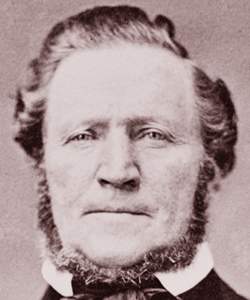Brigham Young (American National Biography)
Scholarship
Young first read a copy of the Book of Mormon in 1830 when it was initially published. He thought highly of it and believed it answered many of his religious questions, but he cautiously wanted to make sure the Mormons were sincere and sensible in their faith. He listened to their traveling missionaries, visited a Mormon congregation in Pennsylvania, prayed with them, was persuaded of their biblical focus, and submitted to baptism in 1832. He and a friend immediately traveled to Kirtland, Ohio, to meet the Mormon leader, Joseph Smith, Jr. Young found the 26-year-old prophet to be intelligent, straightforward, well schooled in the Bible, and a genial person. Impressed with the Mormon gospel and its leader, Young, as with many early converts, abandoned his shop and began a series of preaching missions in New York, Pennsylvania, New England, and upper Canada. He returned to the Mormon headquarters in Ohio, where he alternated between preaching in nearby areas and working on the construction of the Mormon temple in Kirtland, which was dedicated in 1836.
In 1834 Young married Mary Ann Angell. That year he joined some two hundred other men in marching with Smith to Jackson County, Missouri, to wrest control of Mormon lands from the anti-Mormon mob that had driven the Mormons out. Although Zions Camp, as it was called, did not achieve its goals, Young learned valuable lessons in how to organize and manage a group of people on the march.
In 1834 Young married Mary Ann Angell. That year he joined some two hundred other men in marching with Smith to Jackson County, Missouri, to wrest control of Mormon lands from the anti-Mormon mob that had driven the Mormons out. Although Zions Camp, as it was called, did not achieve its goals, Young learned valuable lessons in how to organize and manage a group of people on the march.
Leonard J. Arrington, "Young, Brigham," American National Biography Online, February 2000, http://www.anb.org/articles/08/08-01714.html.
Brigham Young, Civil War (American National Biography)
Scholarship
The Utah War ended in 1858 without the loss of life, but friction continued between Colonel Johnston, who distrusted Young and his associates, and the settlers, virtually all of whom were loyal to Young. With the outbreak of the Civil War, the army abandoned the territory, some to fight for the North and some for the South. Young contracted on behalf of the church to erect the hurriedly built transcontinental telegraph within Utah borders and then constructed a church-owned telegraph system to connect each settlement with Salt Lake City and the nation. Not entirely certain of Mormon loyalty to the Union, [President Abraham] Lincoln sent a regiment of California volunteers to Utah. They established Camp Douglas in central Salt Lake City to prevent Indian raids and "watch over the Mormons." Their leader, Patrick Connor, was violently anti-Mormon and used his troops to prospect for minerals in Utah's mountains, hoping to induce a rush of miners to the territory to outnumber the Mormons. Minerals were found, but they could not be economically worked until the completion of the transcontinental railroad in May 1869.
Leonard J. Arrington, "Young, Brigham," American National Biography Online, February 2000, http://www.anb.org/articles/08/08-01714.html.



